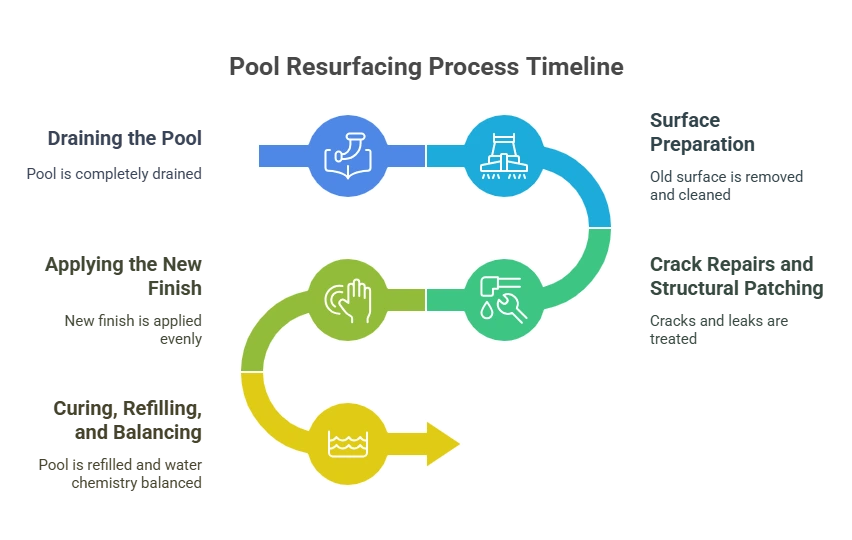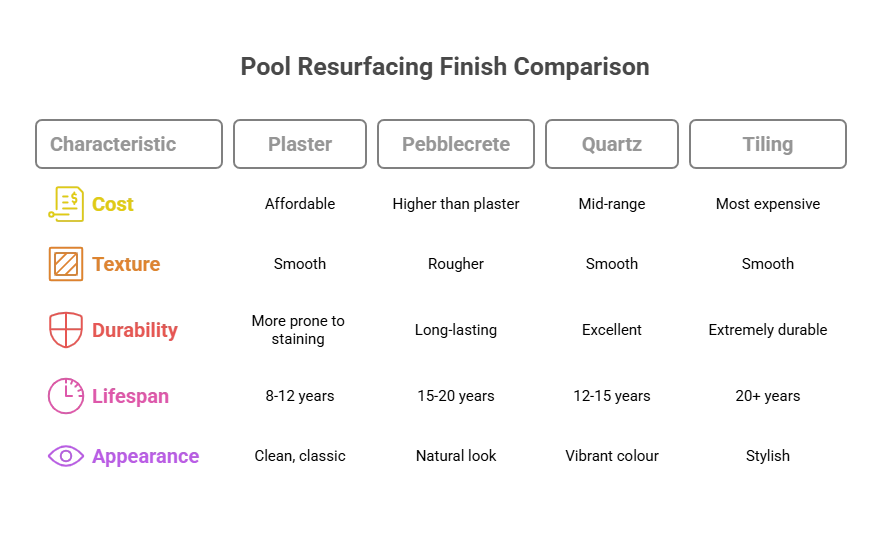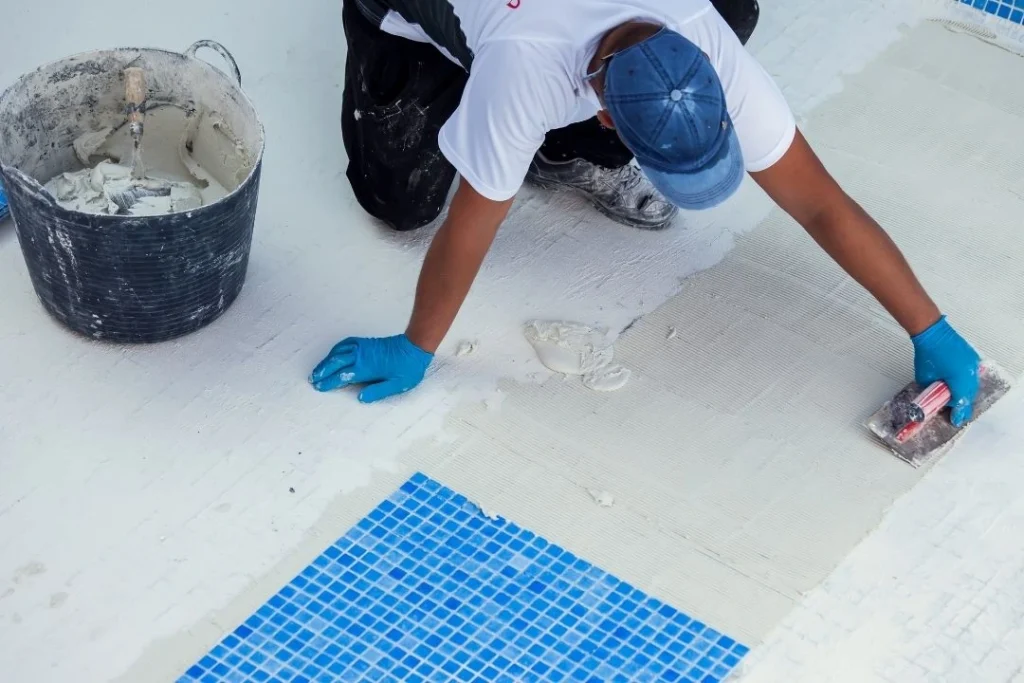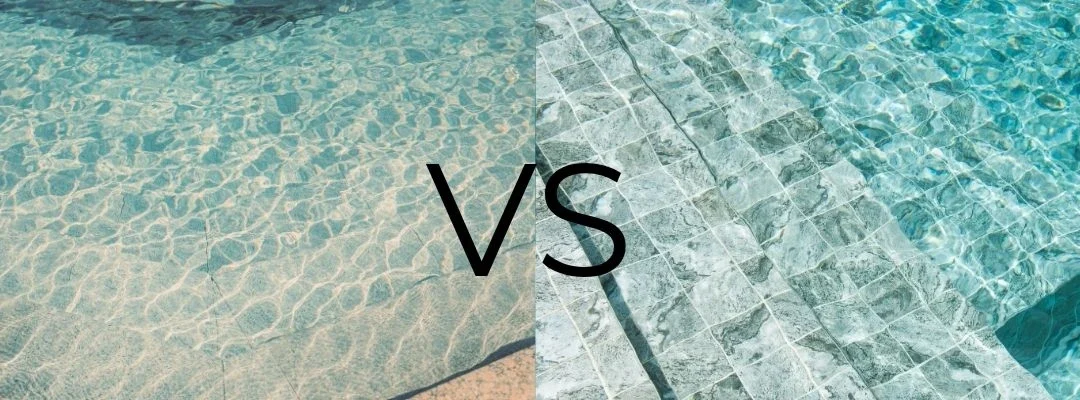Did you know that most concrete pools need resurfacing every 10 to 15 years? Even if yours still looks okay on the outside, the surface underneath might be starting to break down. If your pool is feeling rough, looking patchy, or losing water for no reason, resurfacing might be exactly what it needs. This process not only refreshes the look of your pool but also helps fix hidden issues, improves comfort, and extends its lifespan. In this post, we’ll cover what concrete pool resurfacing involves, when you need it, your finish options, and how it compares to a full renovation.
What is Concrete Pool Resurfacing?
Concrete pool resurfacing is the process of renewing the interior surface of the pool. The original finish can wear down, become rough, or start to crack as the years go by. Resurfacing strips away that damaged layer and replaces it with a fresh and durable finish, giving your pool a whole new lease of life. It’s different from spot repairs or retiling. Those fix isolated issues, while resurfacing treats the entire pool interior.
Most concrete pools need resurfacing roughly every 10 to 15 years, depending on the finish used and how the pool has been maintained. If your pool is nearing that age range or showing signs of wear, resurfacing could be the best way to get it looking and functioning like new again.
Signs It’s Time to Resurface Your Pool
Concrete pools don’t always show obvious signs of wear right away, but the surface can slowly break down over time. Here are some common signs to look out for that might indicate your pool needs resurfacing:
Rough, Peeling, or Flaking Surface
If the surface of your pool feels coarse, scratchy, or even sharp underfoot, it’s a strong indicator that the interior finish is starting to erode. This kind of texture is uncomfortable and can lead to skin irritation and minor injuries like grazes or scrapes. In advanced cases, you might notice the plaster is peeling off in thin layers or flaking away, which is a condition known as spalling. If not addressed immediately, the damage tends to spread, so it’s best to resurface it before it gets worse.
Stains That Won’t Come Off
While some stains are just cosmetic, stubborn discolouration that doesn’t lift with regular cleaning is usually a sign that the surface has become porous or damaged. Rust marks, chemical stains, and algae buildup can settle deep into the material, especially if the protective layer has worn away. These stains make your pool look tired and dirty, but they can also signal deeper problems within the pool shell.

Cracks and Leaks
Hairline cracks in the interior surface might seem small at first, but they can allow water to seep into the underlying structure. When these small cracks aren’t dealt with early on, this can cause bigger issues like structural movement, water loss, or even damage to surrounding areas. If you’re noticing small cracks, surface separation, or unexplained wet patches nearby, it’s worth getting a professional to assess the pool. Resurfacing can often address these early issues before they turn into costly repairs.
Chalky Residue or Cloudy Water
When the surface of your pool starts to break down, it can release fine particles into the water. These may leave a white, powdery film on your skin or make the water cloudy and dull. This breakdown affects water quality and makes maintaining the right chemical balance harder. It can also clog filters and lead to higher maintenance costs.
Unexplained Water Loss
If your water level keeps dropping and there’s no clear cause, it might be seeping through worn or damaged areas in the pool’s surface. Even small leaks can add up over time, leading to higher water bills and potential damage to surrounding landscaping or structures. If you’re constantly topping up your pool, it’s good to have the interior checked for hidden leaks. You can also follow Swimming Pool & Spa Association (SPASA)’s water-saving techniques to reduce unnecessary water loss in the meantime.
The Concrete Pool Resurfacing Process
Wondering what happens during a pool resurfacing job? Here’s what you can expect:
1. Draining the Pool
The first step is to drain the pool completely. This allows the crew to inspect and prepare the surface for work. They make sure that the surface is dried thoroughly before moving forward.
2. Surface Preparation
The next step is either chipping away by hand or removing the old surface with a hydroblasting machine. The entire shell is cleaned, often with a combination of pressure washing and acid washing, to remove residue, algae, and mineral deposits. The goal is to create a clean, textured surface so the new material can bond properly.
3. Crack Repairs and Structural Patching
Any cracks, leaks, or damaged spots are treated at this stage. This might involve applying sealants, structural staples, or patching compounds, depending on the severity. It’s crucial to make sure that the shell is watertight before moving on.

4. Applying the New Finish
Next, your chosen finish is applied. You can choose from plaster, exposed aggregate or pebblecrete, or quartz. The material is then spread evenly and smoothed out across the entire interior. This step requires precision and skill to get the right look and ensure long-term durability.
5. Curing, Refilling, and Balancing
Once the new surface is applied, it needs time to cure. After that, the pool is slowly refilled with water, and the water chemistry is balanced to protect the new surface. This involves monitoring pH levels, calcium hardness, and alkalinity over several days to ensure everything settles properly.
The whole process can take anywhere from a few days to a couple of weeks, depending on weather, materials, and how much prep work is needed. But once it’s done, your pool will look like new again.
Pool Resurfacing Finish Options
Choosing the right finish is a big part of any pool resurfacing project. What you choose for the finish can change the whole vibe of your pool. It can affect how it looks, how it feels when you swim, and how much work it takes to keep it in good shape. Here’s a quick breakdown of the most popular resurfacing finishes used in concrete pools:
Plaster (White or Coloured)
Plaster is the most budget-friendly option. It offers a smooth finish and a clean, classic look, especially in white, which gives your water a light blue glow. You can also choose coloured plaster if you’re after something a little more unique.
Pros: Affordable, smooth surface, clean appearance
Cons: More prone to staining and etching, shorter lifespan
Typical lifespan: 8-12 years
Pebblecrete (Exposed Aggregate)
This is one of the most popular choices. Pebblecrete is a mix of cement and small stones, giving you a textured finish that blends well with natural outdoor settings. It’s highly durable and resistant to staining and wear.
Pros: Long-lasting, great traction, natural look
Cons: Rougher feel underfoot, higher cost than plaster
Typical lifespan: 15-20 years
Quartz Finish
Quartz is a step up from plaster in both performance and appearance. It combines a plaster base with coloured quartz granules, which creates a sparkling, smooth surface that’s more stain- and fade-resistant.
Pros: Smooth texture, vibrant colour, excellent durability
Cons: Mid-range in cost
Typical lifespan: 12-15 years
Tiling
Tiles are the premium option. Whether you choose ceramic, porcelain, or glass, tiling can completely transform your pool’s look with endless design possibilities. It also has the longest lifespan if maintained properly.
Pros: Stylish, easy to clean, extremely durable
Cons: Most expensive, longer installation time
Typical lifespan: 20+ years
Each option has its own balance of cost, aesthetics, and durability. But if you’re still unsure which finish is right for you, a pool professional can help you decide based on your budget, lifestyle, and how you use your pool.

How Much Does Concrete Pool Resurfacing Cost?
The cost of resurfacing a concrete pool on the Gold Coast can vary quite a bit, depending on the size, condition, and the type of finish you choose. Most concrete pool resurfacing jobs start at around $6,000 and can go upwards of $20,000 for larger or complex projects with premium finishes. Tiling or major structural repairs can push the total cost even higher, especially if access is tricky or the existing surface needs a lot of prep work.
What Affects the Cost of Resurfacing?
A few key factors influence how much you’ll pay:
- Pool size. Larger pools need more materials and labour, which increases the overall cost.
- Chosen finish. Basic plaster is usually the most affordable option. Pebblecrete and quartz finishes sit in the mid-to-high range, while tile is the most expensive, but also the most durable.
- Condition of the existing surface. If the pool has cracks, stains, or signs of major wear, it may need extra prep or repairs before the new finish is applied.
- Drainage and access. Pools that are hard to reach or have poor drainage may require more labour and planning. Tight spaces, sloped blocks, or limited equipment access can all contribute to higher costs.
To get an accurate idea of what resurfacing will cost for your pool, it’s always best to book an on-site inspection. That way, you’ll get a tailored quote based on the actual condition and layout of your space.

When to Resurface vs. When to Renovate
While resurfacing is ideal for most ageing concrete pools, it’s not always the right solution. In some cases, the issues go deeper than the surface and call for a full renovation instead, which includes the resurfacing process in addition to other remediation works, addressing many common problems with aging concrete pools.
Here’s when resurfacing is usually enough:
- The surface is rough, stained, or worn out
- There are small cracks or minor leaks
- The structure of the pool is still sound
- You just want a new look or updated finish
But if you’re dealing with more serious problems, a full pool renovation might be the better longer-term solution. Signs that your pool might need a renovation include:
- Major cracks running through the pool shell
- Structural movements or shifting
- Severe water loss from areas that can’t be patched
- Old concrete that’s crumbling or failing in large sections
It can be hard to tell just by looking, so the best way to know what your pool really needs is with a professional inspection. A qualified pool technician can assess the condition of the shell, surface, and structure, and help you decide whether resurfacing will do the trick or if it’s time to start fresh.
Is It Time to Resurface Your Pool?
Concrete pool resurfacing is one of the best ways to breathe new life into your outdoor space. Whether your pool’s surface is rough, stained, or starting to crack, resurfacing can make it look and feel like new again without the cost of a full rebuild. It’s a smart move to boost comfort, improve safety, and help your pool last for years. And if you’re not sure what your pool needs, a quick inspection can give you clear answers and peace of mind.
Think your pool might be ready for a refresh? Don’t wait for small issues to turn into costly repairs. Reach out to our team to book a free onsite consultation and get a personalised quote! Let’s bring your pool back to life and turn it into a space you’ll love spending time in again.


